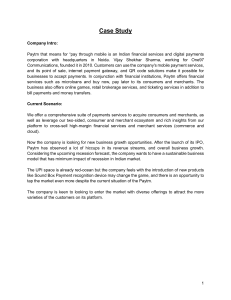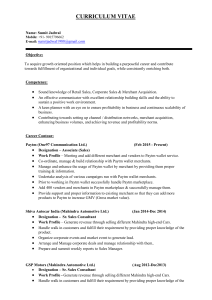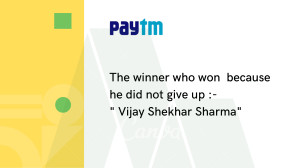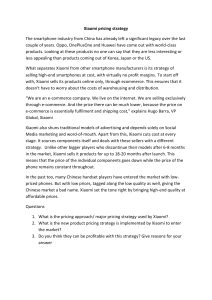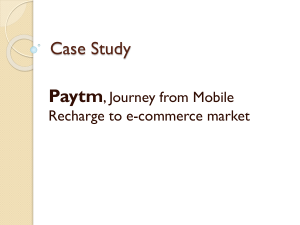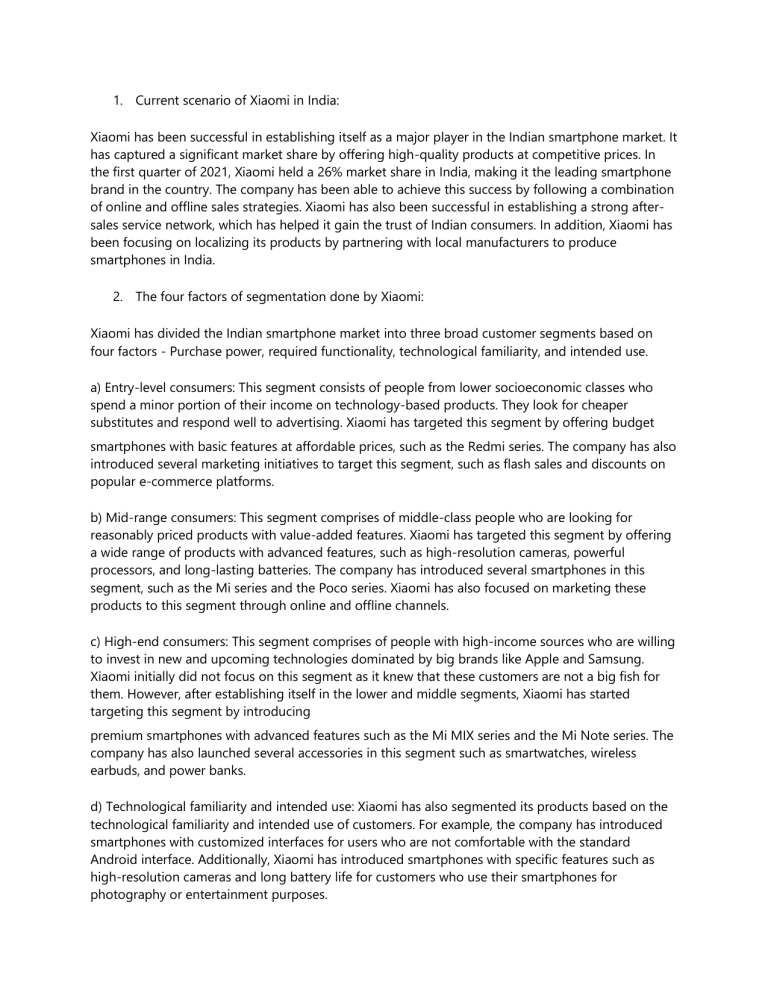
1. Current scenario of Xiaomi in India: Xiaomi has been successful in establishing itself as a major player in the Indian smartphone market. It has captured a significant market share by offering high-quality products at competitive prices. In the first quarter of 2021, Xiaomi held a 26% market share in India, making it the leading smartphone brand in the country. The company has been able to achieve this success by following a combination of online and offline sales strategies. Xiaomi has also been successful in establishing a strong aftersales service network, which has helped it gain the trust of Indian consumers. In addition, Xiaomi has been focusing on localizing its products by partnering with local manufacturers to produce smartphones in India. 2. The four factors of segmentation done by Xiaomi: Xiaomi has divided the Indian smartphone market into three broad customer segments based on four factors - Purchase power, required functionality, technological familiarity, and intended use. a) Entry-level consumers: This segment consists of people from lower socioeconomic classes who spend a minor portion of their income on technology-based products. They look for cheaper substitutes and respond well to advertising. Xiaomi has targeted this segment by offering budget smartphones with basic features at affordable prices, such as the Redmi series. The company has also introduced several marketing initiatives to target this segment, such as flash sales and discounts on popular e-commerce platforms. b) Mid-range consumers: This segment comprises of middle-class people who are looking for reasonably priced products with value-added features. Xiaomi has targeted this segment by offering a wide range of products with advanced features, such as high-resolution cameras, powerful processors, and long-lasting batteries. The company has introduced several smartphones in this segment, such as the Mi series and the Poco series. Xiaomi has also focused on marketing these products to this segment through online and offline channels. c) High-end consumers: This segment comprises of people with high-income sources who are willing to invest in new and upcoming technologies dominated by big brands like Apple and Samsung. Xiaomi initially did not focus on this segment as it knew that these customers are not a big fish for them. However, after establishing itself in the lower and middle segments, Xiaomi has started targeting this segment by introducing premium smartphones with advanced features such as the Mi MIX series and the Mi Note series. The company has also launched several accessories in this segment such as smartwatches, wireless earbuds, and power banks. d) Technological familiarity and intended use: Xiaomi has also segmented its products based on the technological familiarity and intended use of customers. For example, the company has introduced smartphones with customized interfaces for users who are not comfortable with the standard Android interface. Additionally, Xiaomi has introduced smartphones with specific features such as high-resolution cameras and long battery life for customers who use their smartphones for photography or entertainment purposes. In conclusion, Xiaomi has used a combination of traditional marketing mix and customized marketing strategies to establish itself in the Indian smartphone market. The company has focused on product segmentation based on purchase power, required functionality, technological familiarity, and intended use of customers to effectively target different segments. This has allowed Xiaomi to capture a significant market share in India and compete with domestic and international players Paytm Paytm is one of the leading mobile payment and financial services providers in India. The company has a significant presence in the digital payments industry and has been successful in establishing itself as a reliable and convenient payment platform for millions of users in India. Marketing Strategy for Paytm: Paytm's existing marketing strategy includes a range of activities, including social media marketing, influencer marketing, and television advertising. Paytm has also been active in promoting its services through sponsorship of major sporting events and by providing cashback offers to its customers. To design a new marketing strategy for Paytm, we should focus on leveraging their existing strengths, such as their widespread user base and brand recognition, while also exploring new marketing channels. Some possible strategies that Paytm could adopt include: Localized marketing: Paytm could focus on creating localized marketing campaigns to target specific regions or demographics. This could include partnering with local businesses to offer exclusive deals or discounts to Paytm users in those areas. Content marketing: Paytm could invest in creating high-quality, informative content to educate potential customers about the benefits of using their platform. This could include blog posts, videos, and infographics that explain how to use Paytm and the advantages of digital payments over traditional payment methods. Collaborations with influencers: Paytm could collaborate with popular social media influencers to promote its services to their followers. This could involve sponsoring posts or creating custom campaigns that highlight the benefits of using Paytm for online transactions. Revenue Model of Paytm: Paytm generates revenue through a range of sources, including transaction fees, commissions on bill payments and recharges, and interest on funds held in Paytm wallets. Paytm has also expanded its offerings to include other financial services, such as insurance, investments, and loans. This has allowed the company to diversify its revenue streams and capture a larger share of the financial services market. Some possible new revenue sources for Paytm include: Advertising: Paytm could generate additional revenue by offering targeted advertising opportunities to businesses on its platform. This could involve displaying ads to users based on their transaction history, interests, and demographics. Merchant services: Paytm could expand its merchant services offerings to include point-of-sale systems, inventory management software, and other tools to help businesses streamline their operations. This could provide an additional revenue stream for Paytm and increase the value proposition for merchants who use its platform. Cross-selling financial services: Paytm could cross-sell other financial services to its existing user base, such as credit cards, mutual funds, or retirement plans. By leveraging its existing customer relationships, Paytm could generate additional revenue and strengthen its position in the financial services market. In conclusion, by adopting new marketing strategies and exploring new revenue sources, Paytm can continue to grow its business and remain competitive in the digital payments and financial services industry. HUL The case study highlights Hindustan Unilever Limited (HUL), the Indian subsidiary of Unilever, which is a leading player in the Indian consumer products market. HUL's product portfolio includes foods, beverages, cleaning agents, personal care products, water purifiers, and consumer goods. HUL has been in operation since 1933 and has evolved over the years to become a market leader in Indian consumer products with a presence in over 20 consumer categories. The company has a strong distribution system and an extensive product line, which has contributed to its success. HUL has faced challenges in the market due to the presence of competitors, customer buying power, and availability of substitutes at different prices, among others. HUL has positioned itself as a leading player in the Indian consumer products market by leveraging its strong brand visibility, innovative product offerings, and extensive distribution system. The company has a diversified product portfolio, catering to various consumer categories such as soaps, tea, detergents, and shampoos, among others. HUL has also been proactive in expanding its market and creating awareness among customers about its products. The company has consistently focused on innovation to offer unique and differentiated products to customers. HUL has established an integrated distribution system that covers a wide range of retail channels, enabling it to reach a large customer base. Overall, HUL has positioned itself as a reliable and trustworthy brand that offers high-quality products to its customers.
